
Perfectly streamlined for piercing water at 100 kmph, a northern gannet’s spear-like bill makes a formidable weapon in territorial disputes

It is the largest seabird in the north Atlantic - just under a metre from pointed tip to pointed tail, with wingtips twice that distance apart

75% of the global breeding population nest in colonies on coastal cliffs, sea stacks and remote islands around the UK. The Bass Rock is the largest single rock gannetry on Earth

Proposed offshore wind farms in the Firth of Forth threaten to disturb the Bass gannetry if turbines are sited in the birds' foraging zones. Scientific study is underway to determine the potential impacts

A team of researchers led by Keith Hamer and James Grecian head out to Bass during breeding season. Adult gannets must regularly feed their young, making it the perfect time to study foraging behaviours

Historically, the Bass was an island prison. The gannetry has become so large that some birds have taken up residence inside the ruins. Like guardians of the gate, these jail birds block the passage into the colony

Once past the prison, the team carry their kit, including long gannet catching rods through the colony and up to the study area
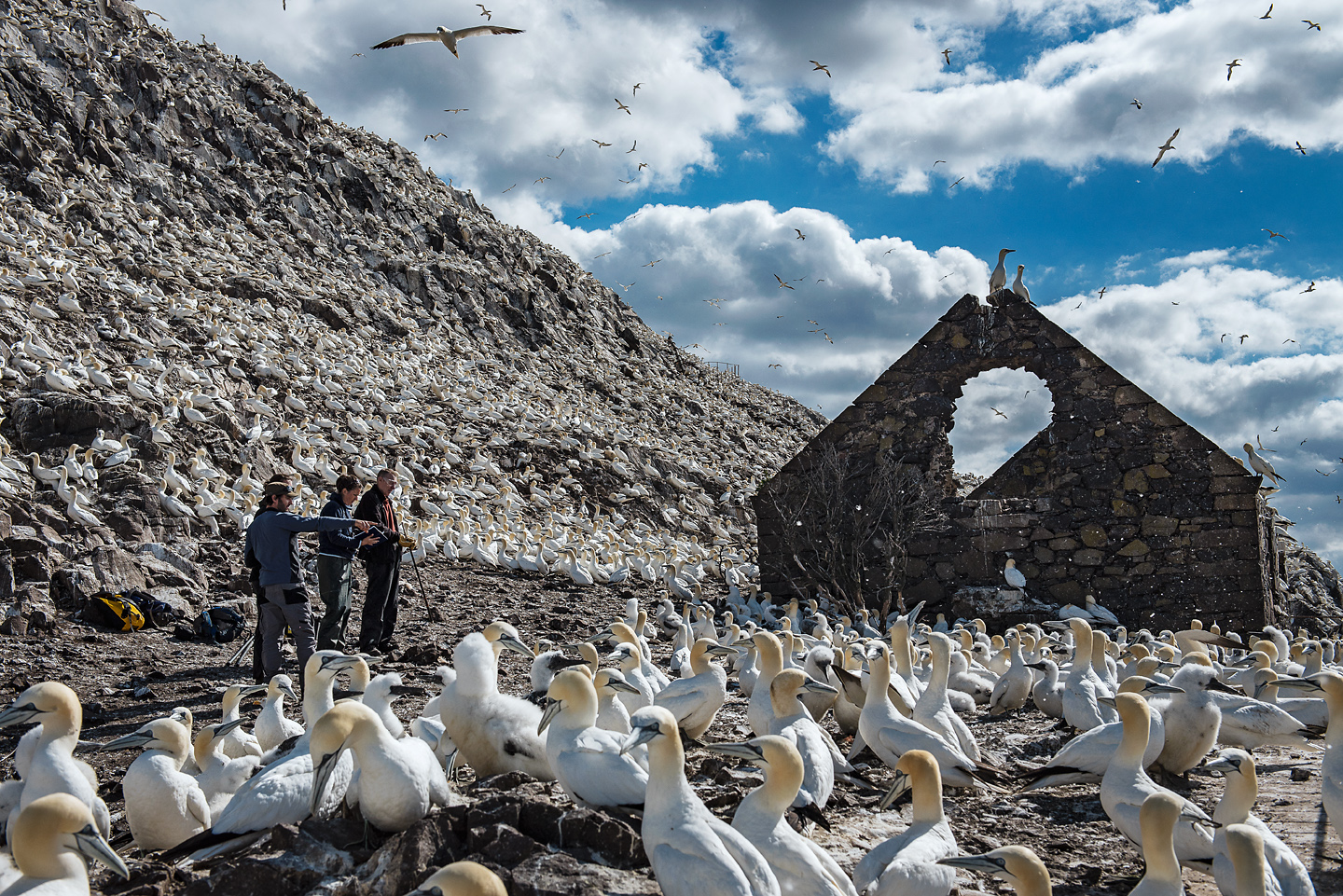
Outside the ruins of an ancient chapel, the team look for previous study birds and single out individuals to attach with monitoring devices

Data can be downloaded remotely from gannets attached with high resolution GPS loggers

Those with more basic GPS loggers must be re-caught in order to retrieve their data

Adults with loggers attached are caught when they return to feed their young. It has been discovered that some make two day foraging trips as far away as the Norwegian coast

Adult gannets are formidable, powerfully built and solid. Catching them can sometimes be a two person job
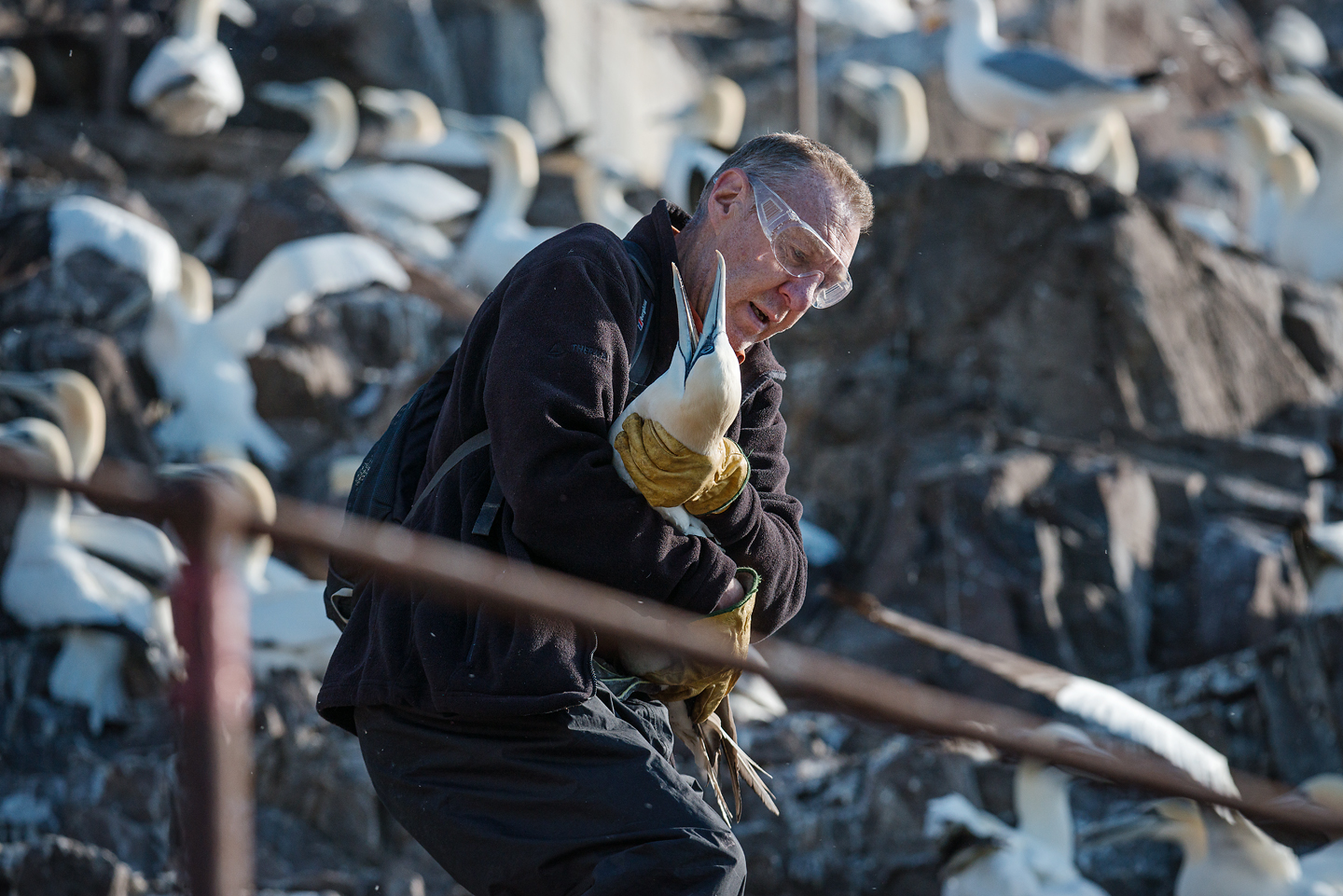
Eye protection must be worn at all times - a peck from a gannet’s dagger-like bill could be blinding

Measurements are taken and Darvic leg rings with large characters are attached so that individual birds can be recognised from a distance

Data from attached altimeters is combined with GPS data to determine flight altitude and most importantly how much time is spent at a similar height to the rotor blades of wind turbines
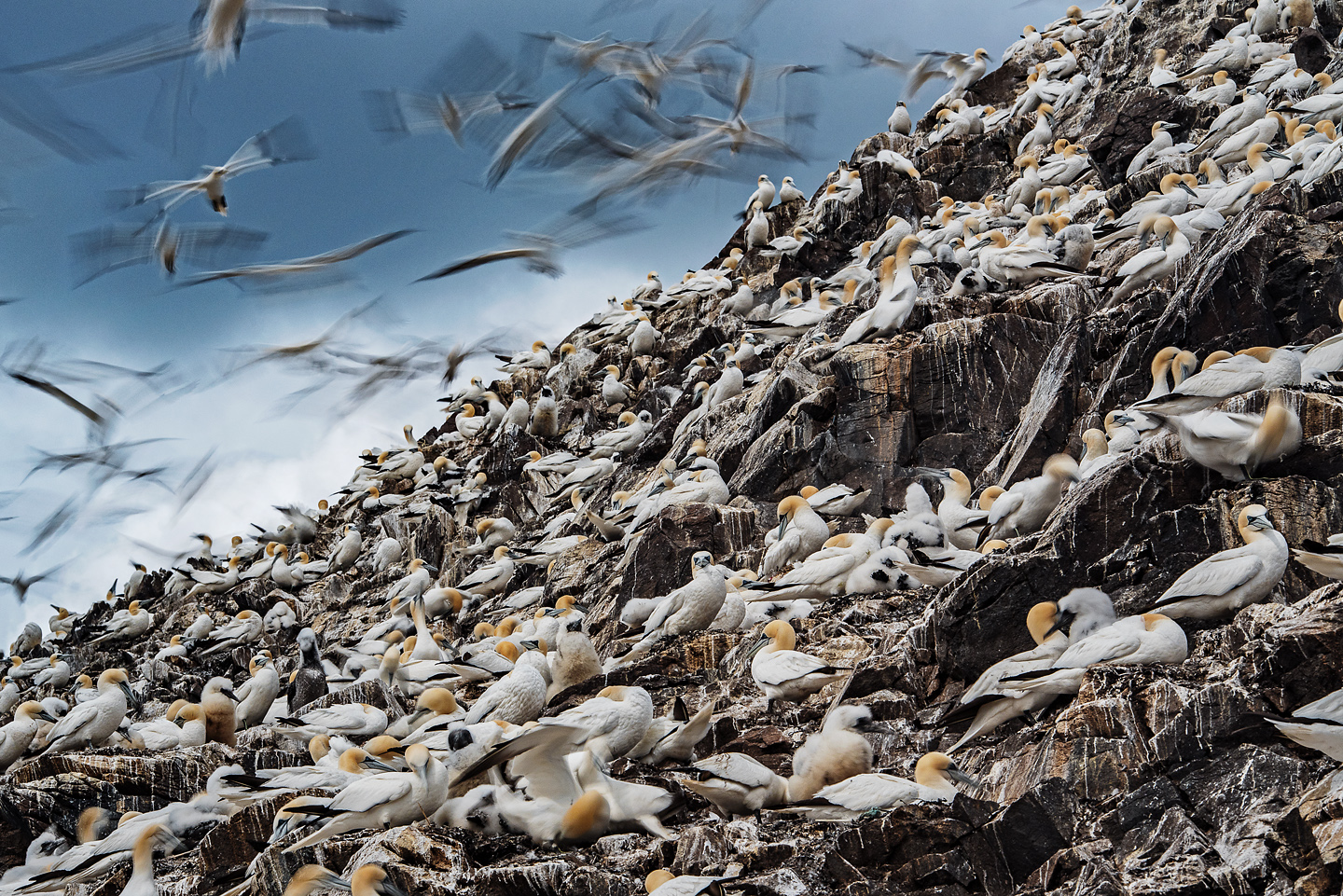
Understanding flight behaviours in 3D and identifying areas of overlap with proposed offshore development has implications for the future of the entire northern gannet species
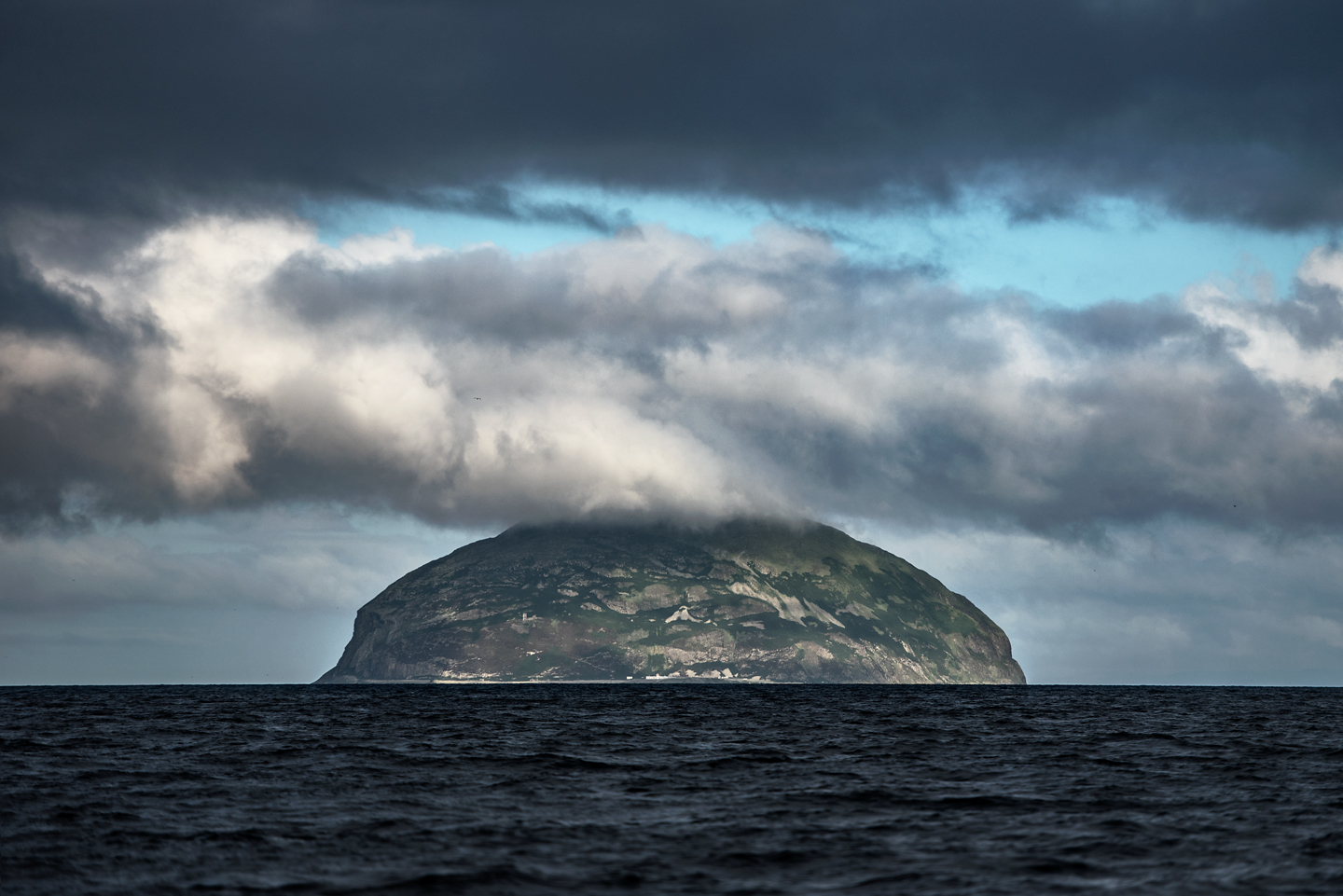
Ailsa Craig in the Firth of Clyde is another study site with 36 000 breeding pairs of gannets. This granite rock is formed from the volcanic plug of an extinct volcano

James Grecian and Jude Lane are undertaking a pioneering study of immature gannets on Ailsa and Bass. Very little is known about the behaviour of these young birds
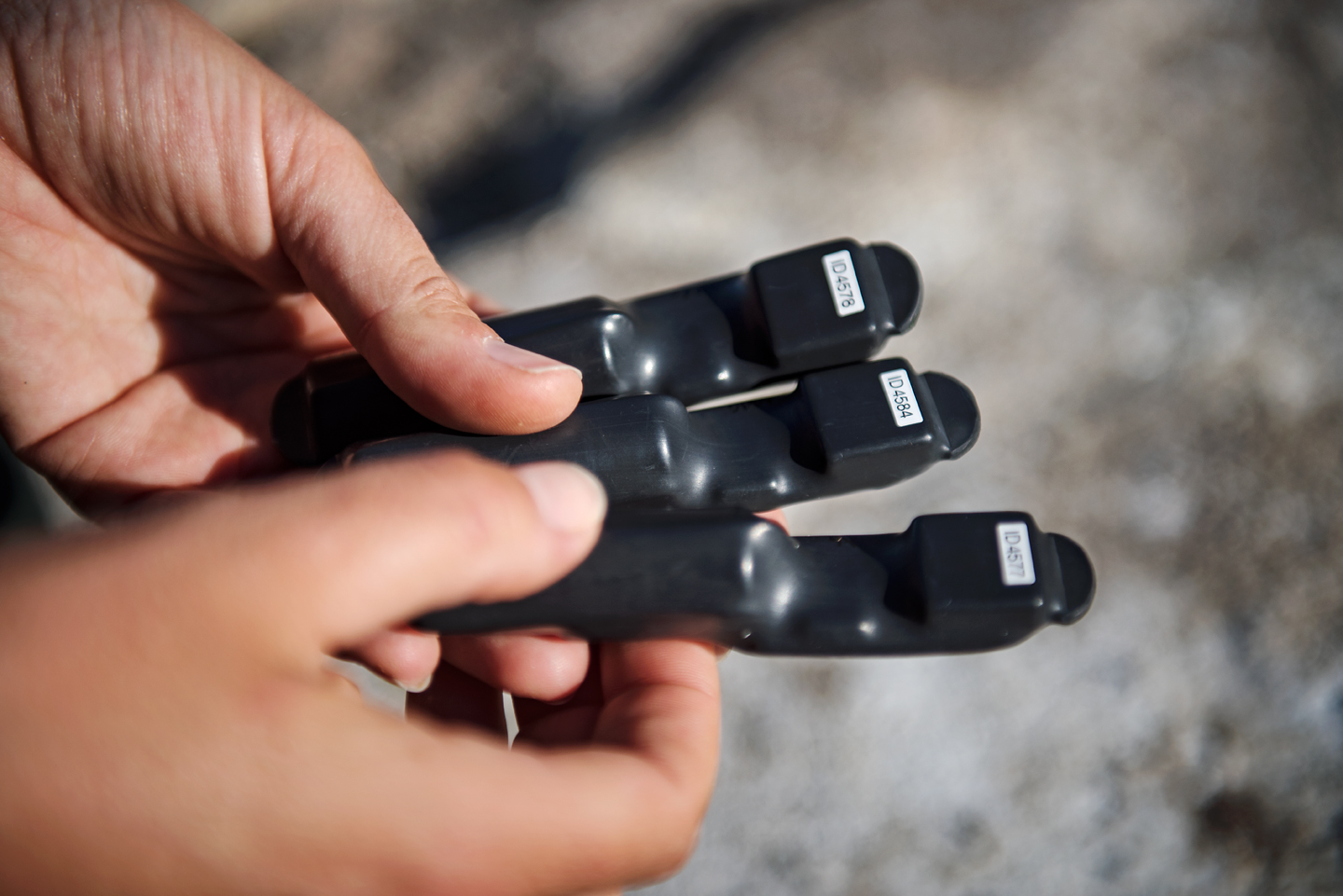
Gannets may not breed until they are 5 or 6 and spend their early years learning the best foraging areas and prospecting territory. GPS data is shedding light on the behaviour of these elusive birds for the first time

Re-capture of immature birds is impractical, so movements are tracked and data is downloaded from the cliff above the colony. Data loggers will drop off during the next moult

Offshore development is unfortunately not the only human activity affecting the UK’s gannet population. Waste from Atlantic fisheries is causing devastation on an island just 8 miles off the Welsh coast

Synthetic plastic fishing nets and monofilament fishing lines discarded in the Atlantic are washed into close proximity with Grassholm Island in Pembrokeshire by ocean currents like the Gulf Stream

Gannets mistake the man-made floating debris for natural fibres like seaweed and kelp and bring it on to the island to line their nests. It is estimated that there is now 18.5 tons of plastic waste on Grassholm

Plastic fibres are a deadly combination of incredibly strong and extremely cheap to produce. This makes them easily disposable and unlike natural fibres, nearly impossible to escape from once entangled

Nests become death-traps, with panicked and struggling birds becoming increasingly entangled. This bird hangs from the cliff edge, strangled by a tightening noose around its neck

Juvenile birds are often the worst affected, with ropes continually constricting their limbs as they grow and develop

A team of volunteers led by RSPB Ramsey Island warden Greg Morgan visit Grassholm each year at the end of the breeding season. They are on a rescue mission to save as many gannets as possible from this death sentence

Often risking their own lives to save gannets hanging from tall sea-cliffs, the team rescue an average of 50 birds each year. Gannets can live for 35 years, so the survival of even a single bird will affect the reproductive success of the colony

Entanglement in plastic nets is not the only problem - gannets often ingest fishing lines and other floating debris like released balloons

Heavy-duty packing straps used to secure boxes on cargo ships can also be particularly deadly

On average, a gannet’s nest on Grassholm contains half a kilogram of plastic, but this ranges to well over a kilogram. Synthetic fibres can make up the majority of the nest, so removal is not an option

Removing the plastic would mean destroying nests and for a species which returns to the same nest each year, this would be too disruptive to the colony

Unfortunately exacerbation of this desperate situation where gannets tear off their own limbs rather than face certain starvation is likely as the amount of plastic in the ocean gradually increases

Dead gannets become a part of the landscape on Grassholm and all Greg and the volunteers can do is continue to firefight the situation and save as many birds as they can

Education about marine plastics and gaining a better understanding of the behaviours of this most charismatic of seabirds is the only long term solution to protecting the species

The UK has a great responsibility to protect the northern gannet. Being home to 3/4 of the global population, any policy made that affects gannets in the UK will have ramifications for the health of the species

It has been said that the Bass Rock, home to a tenth of the world’s northern gannets is one of the wonders of the natural world. Preventing potential disturbance to this national treasure makes the current research of the utmost importance

The gannet is a marvel of nature, with reinforced bones, natural swimming goggles, no external nostrils and air sacs which protect it as it smashes like a glorious white arrow into the depths of darkness

This blue-eyed beauty, expert angler, faithful partner and attentive parent leads the extreme life of a mariner for most of the year, traversing oceans in the wildest of weathers

That the current population is thriving and that so many return to the UK each year to nest is a privilege that deserves to be cherished and celebrated








































Perfectly streamlined for piercing water at 100 kmph, a northern gannet’s spear-like bill makes a formidable weapon in territorial disputes
It is the largest seabird in the north Atlantic - just under a metre from pointed tip to pointed tail, with wingtips twice that distance apart
75% of the global breeding population nest in colonies on coastal cliffs, sea stacks and remote islands around the UK. The Bass Rock is the largest single rock gannetry on Earth
Proposed offshore wind farms in the Firth of Forth threaten to disturb the Bass gannetry if turbines are sited in the birds' foraging zones. Scientific study is underway to determine the potential impacts
A team of researchers led by Keith Hamer and James Grecian head out to Bass during breeding season. Adult gannets must regularly feed their young, making it the perfect time to study foraging behaviours
Historically, the Bass was an island prison. The gannetry has become so large that some birds have taken up residence inside the ruins. Like guardians of the gate, these jail birds block the passage into the colony
Once past the prison, the team carry their kit, including long gannet catching rods through the colony and up to the study area
Outside the ruins of an ancient chapel, the team look for previous study birds and single out individuals to attach with monitoring devices
Data can be downloaded remotely from gannets attached with high resolution GPS loggers
Those with more basic GPS loggers must be re-caught in order to retrieve their data
Adults with loggers attached are caught when they return to feed their young. It has been discovered that some make two day foraging trips as far away as the Norwegian coast
Adult gannets are formidable, powerfully built and solid. Catching them can sometimes be a two person job
Eye protection must be worn at all times - a peck from a gannet’s dagger-like bill could be blinding
Measurements are taken and Darvic leg rings with large characters are attached so that individual birds can be recognised from a distance
Data from attached altimeters is combined with GPS data to determine flight altitude and most importantly how much time is spent at a similar height to the rotor blades of wind turbines
Understanding flight behaviours in 3D and identifying areas of overlap with proposed offshore development has implications for the future of the entire northern gannet species
Ailsa Craig in the Firth of Clyde is another study site with 36 000 breeding pairs of gannets. This granite rock is formed from the volcanic plug of an extinct volcano
James Grecian and Jude Lane are undertaking a pioneering study of immature gannets on Ailsa and Bass. Very little is known about the behaviour of these young birds
Gannets may not breed until they are 5 or 6 and spend their early years learning the best foraging areas and prospecting territory. GPS data is shedding light on the behaviour of these elusive birds for the first time
Re-capture of immature birds is impractical, so movements are tracked and data is downloaded from the cliff above the colony. Data loggers will drop off during the next moult
Offshore development is unfortunately not the only human activity affecting the UK’s gannet population. Waste from Atlantic fisheries is causing devastation on an island just 8 miles off the Welsh coast
Synthetic plastic fishing nets and monofilament fishing lines discarded in the Atlantic are washed into close proximity with Grassholm Island in Pembrokeshire by ocean currents like the Gulf Stream
Gannets mistake the man-made floating debris for natural fibres like seaweed and kelp and bring it on to the island to line their nests. It is estimated that there is now 18.5 tons of plastic waste on Grassholm
Plastic fibres are a deadly combination of incredibly strong and extremely cheap to produce. This makes them easily disposable and unlike natural fibres, nearly impossible to escape from once entangled
Nests become death-traps, with panicked and struggling birds becoming increasingly entangled. This bird hangs from the cliff edge, strangled by a tightening noose around its neck
Juvenile birds are often the worst affected, with ropes continually constricting their limbs as they grow and develop
A team of volunteers led by RSPB Ramsey Island warden Greg Morgan visit Grassholm each year at the end of the breeding season. They are on a rescue mission to save as many gannets as possible from this death sentence
Often risking their own lives to save gannets hanging from tall sea-cliffs, the team rescue an average of 50 birds each year. Gannets can live for 35 years, so the survival of even a single bird will affect the reproductive success of the colony
Entanglement in plastic nets is not the only problem - gannets often ingest fishing lines and other floating debris like released balloons
Heavy-duty packing straps used to secure boxes on cargo ships can also be particularly deadly
On average, a gannet’s nest on Grassholm contains half a kilogram of plastic, but this ranges to well over a kilogram. Synthetic fibres can make up the majority of the nest, so removal is not an option
Removing the plastic would mean destroying nests and for a species which returns to the same nest each year, this would be too disruptive to the colony
Unfortunately exacerbation of this desperate situation where gannets tear off their own limbs rather than face certain starvation is likely as the amount of plastic in the ocean gradually increases
Dead gannets become a part of the landscape on Grassholm and all Greg and the volunteers can do is continue to firefight the situation and save as many birds as they can
Education about marine plastics and gaining a better understanding of the behaviours of this most charismatic of seabirds is the only long term solution to protecting the species
The UK has a great responsibility to protect the northern gannet. Being home to 3/4 of the global population, any policy made that affects gannets in the UK will have ramifications for the health of the species
It has been said that the Bass Rock, home to a tenth of the world’s northern gannets is one of the wonders of the natural world. Preventing potential disturbance to this national treasure makes the current research of the utmost importance
The gannet is a marvel of nature, with reinforced bones, natural swimming goggles, no external nostrils and air sacs which protect it as it smashes like a glorious white arrow into the depths of darkness
This blue-eyed beauty, expert angler, faithful partner and attentive parent leads the extreme life of a mariner for most of the year, traversing oceans in the wildest of weathers
That the current population is thriving and that so many return to the UK each year to nest is a privilege that deserves to be cherished and celebrated
